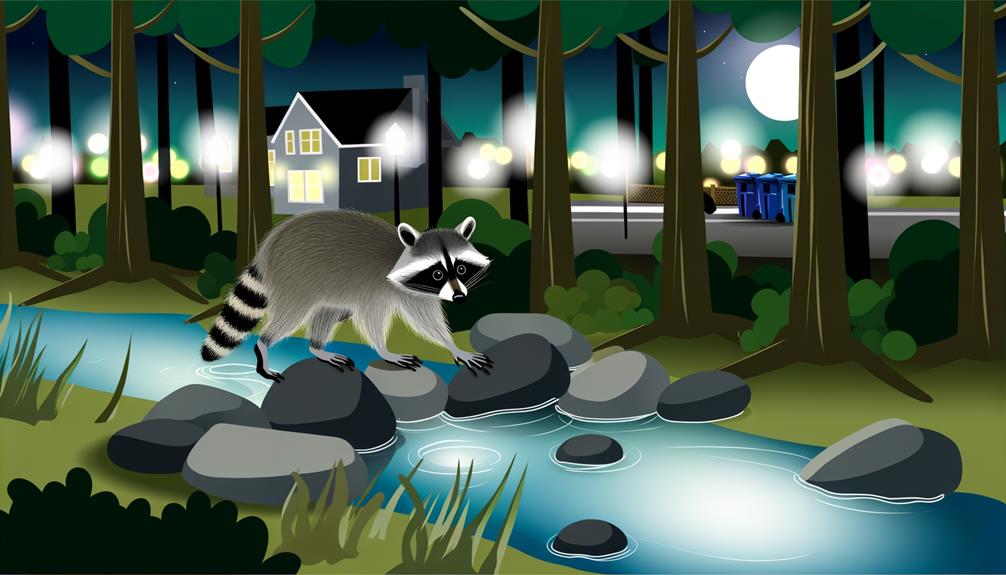How Far Do Raccoons Travel for Food?
Raccoons exhibit varied travel patterns for food, typically ranging from a few hundred meters to over five kilometers based on resource availability. In resource-rich urban areas, their foraging is confined to 500 meters to 3 kilometers.
In rural environments, they traverse expansive territories of up to 20 kilometers. Seasonal variations influence these distances, with shorter journeys in spring and summer and extended travels in autumn.
Food scarcity prompts longer foraging trips, while abundant resources localize their activities. The impact of human activities further modifies their movement and diet.
For greater insights into raccoon foraging behaviors and the factors affecting them, keep exploring.

Key Takeaways
- Raccoons typically forage within 500 meters in areas with abundant resources.
- In less resource-rich environments, raccoons can travel up to 5 kilometers for food.
- Urban raccoons have smaller home ranges, usually between 1 to 3 kilometers.
- Rural raccoons may navigate territories spanning 8 to 20 kilometers.
- Seasonal food availability and environmental conditions significantly influence raccoon travel distances.
Raccoon Foraging Patterns

Raccoon foraging patterns are characterized by their opportunistic and highly adaptable nature, allowing them to exploit a wide range of food sources in various environments. These mammals exhibit a remarkable ability to adjust their diet based on available resources, consuming fruits, nuts, small animals, insects, and even human refuse.
Their foraging behavior is largely nocturnal, with peak activity occurring during the night when they are less likely to encounter predators. Raccoons use their dexterous front paws to manipulate and inspect potential food items, demonstrating significant problem-solving skills.
This adaptability not only supports their survival in diverse habitats, from forests to urban areas, but also contributes to their success as a species in varying ecological contexts.
Typical Travel Distances
Characterized by their adaptability and resourcefulness, these nocturnal mammals typically travel distances ranging from a few hundred meters to several kilometers in search of food, depending on the availability of resources and environmental conditions.
In areas where food sources are abundant and easily accessible, raccoons may limit their foraging to smaller territories, often within a radius of 500 meters. Conversely, in less resource-rich environments, they may extend their range significantly, traveling up to 5 kilometers or more.
The variability in their travel distances underscores the raccoon's opportunistic feeding behavior, allowing them to exploit a wide range of habitats. This dynamic foraging strategy ensures their survival across diverse ecological settings, highlighting their remarkable adaptability and resilience.
Urban Vs. Rural Movement

The movement patterns of raccoons exhibit significant differences between urban and rural environments, largely influenced by the availability of food sources.
In urban areas, raccoons often exploit readily accessible human-generated waste, resulting in shorter travel distances.
Conversely, in rural areas, raccoons engage in more extensive foraging activities, necessitating longer travel distances to locate natural food sources.
Urban Food Sources
Urban environments offer raccoons a plethora of easily accessible food sources, prompting significant differences in their movement patterns compared to their rural counterparts. The abundance of garbage bins, pet food, and food waste in urban areas enables raccoons to find sustenance within smaller territories, reducing the need for extensive travel.
Studies indicate that urban raccoons often exhibit smaller home ranges, typically between 1 to 3 kilometers, as they can exploit a more concentrated array of food resources. This contrasts sharply with rural raccoons, which may need to traverse larger distances to locate adequate food.
Consequently, urban raccoons can allocate more energy to reproduction and survival, benefiting from the predictable and plentiful food supply inherent to city landscapes.
Rural Foraging Habits
Contrasting with their urban counterparts, rural raccoons must navigate expansive territories, often spanning 8 to 20 kilometers, to secure sufficient food resources. This extensive range is primarily driven by the lower density of food sources in rural environments, necessitating greater movement to locate sustenance.
Rural raccoons rely heavily on natural food items such as fruits, nuts, insects, and small animals, which are distributed unevenly across large areas. Additionally, agricultural fields and forest patches create a mosaic of habitats that influence their foraging routes.
Unlike urban raccoons, who benefit from abundant anthropogenic food waste, rural raccoons face seasonal variations in food availability, further compelling them to cover larger distances to meet their dietary needs. This dynamic underscores the adaptability of raccoons in diverse environments.
Travel Distance Variances
Examining how travel distances differ between urban and rural raccoons reveals stark contrasts in their foraging behavior and spatial use. Urban raccoons, benefiting from abundant food sources such as household waste, often travel shorter distances. In contrast, rural raccoons must traverse larger areas to locate their more dispersed, natural food sources.
Key factors influencing these variances include:
- Resource Density: Urban areas have concentrated food, reducing the need for extensive travel.
- Habitat Fragmentation: Cities present numerous barriers, leading to smaller, more confined territories.
- Predator Presence: Rural raccoons face fewer human threats but more natural predators, influencing their movement patterns.
Such differences underscore the adaptability of raccoons to diverse ecological contexts and their ability to optimize foraging strategies based on environmental conditions.
Seasonal Variations
During different seasons, raccoons exhibit distinct patterns in their foraging behavior driven by changes in food availability and environmental conditions. In spring, they exploit newly available resources such as insects and budding vegetation. Summer sees raccoons traveling shorter distances due to the abundance of fruits, nuts, and small animals. Conversely, autumn prompts extended foraging ranges as raccoons prepare for winter by seeking high-calorie foods like acorns and fish. Winter behavior is characterized by reduced activity and minimal travel, driven by scarcity and energy conservation needs.
| Season | Foraging Behavior |
|---|---|
| Spring | Short distances, diverse diet |
| Summer | Short distances, abundant food |
| Autumn | Long distances, high-calorie diet |
| Winter | Minimal travel, energy conservation |
Impact of Food Availability

Food availability plays an essential role in shaping the foraging strategies and movement patterns of raccoons throughout the year. When food is abundant, raccoons exhibit more localized foraging behavior, thereby reducing their travel distances. Conversely, scarcity of food prompts raccoons to expand their range in search of sustenance, often leading to increased interactions with human habitats.
Key factors influencing food availability include:
- Seasonal fluctuations: Natural food sources such as fruits and insects vary with the seasons.
- Human activities: Waste management practices and urbanization provide consistent, albeit artificial, food sources.
- Habitat diversity: Varied ecosystems offer multiple foraging opportunities within close proximity.
Understanding these factors is critical to comprehending raccoon movement and the broader ecological impacts of their foraging behavior.
Role of Water Sources
Water sources play a pivotal role in determining the movement patterns and habitat preferences of raccoons. Raccoons are semi-aquatic mammals that rely heavily on proximity to water for both hydration and foraging opportunities.
The presence of rivers, streams, and ponds not only provides drinking water but also supports a richer diversity of prey, such as fish, amphibians, and aquatic invertebrates. This abundance of resources influences raccoons to establish their dens and foraging areas near water.
Additionally, water bodies offer raccoons a means of escape from terrestrial threats and aid in their nocturnal activities, which involve meticulous washing of food. In this way, water sources play a significant role in shaping the spatial ecology and daily routines of raccoons.
Predators and Safety

The survival strategies of raccoons are greatly influenced by the presence of predators, necessitating a keen awareness of safety in their habitat selection and daily activities. Raccoons must remain vigilant against various threats, which impacts their foraging patterns and distances traveled for food.
Key predators include:
- Coyotes: Agile hunters that can track raccoons over diverse terrains.
- Great Horned Owls: Nocturnal birds of prey capable of silent attacks from above.
- Domestic Dogs: Often found in suburban areas, posing significant threats during nighttime scavenging.
Awareness of these predators compels raccoons to adopt nocturnal habits, utilize complex den networks, and prefer habitats with dense vegetation for cover. Consequently, the interplay between predator presence and safety considerations is a critical determinant of raccoon movement and behavior.
Human Activity Influence
Human activity significantly alters the foraging behavior and habitat selection of raccoons, often compelling them to navigate urban and suburban environments in search of food resources. Urbanization leads to habitat fragmentation, reducing natural food availability and increasing reliance on anthropogenic sources such as garbage, pet food, and garden produce.
This shift not only modifies raccoon diet but also influences their movement patterns and ranges. Urban raccoons tend to have smaller home ranges than their rural counterparts due to the higher density of food resources. Additionally, human-provided food sources can cause raccoons to become habituated to human presence, potentially increasing human-wildlife conflicts.
Therefore, understanding these influences is essential for effective wildlife management and mitigating the impacts of urban expansion on raccoon populations.
Tracking Raccoon Movements

Effective tracking of raccoon movements necessitates the deployment of advanced telemetry and GPS technologies to gather precise data on their spatial and temporal patterns. These methodologies enable researchers to observe the intricate details of raccoon behavior, providing insights into their foraging habits and movement ranges.
By utilizing these technologies, the following data can be collected:
- Home range size: Determining the geographical area that an individual raccoon frequents.
- Movement corridors: Identifying the routes raccoons typically use to travel between feeding sites.
- Activity patterns: Observing the timing and frequency of raccoon movements, particularly in relation to food availability.
Such detailed tracking systems are indispensable for understanding the behavioral ecology of raccoons and their adaptive strategies in various environments.
Implications for Wildlife Management
Understanding raccoon movement patterns through advanced telemetry and GPS technologies provides invaluable data that can be leveraged to enhance wildlife management strategies.
By analyzing the spatial and temporal aspects of raccoon foraging behavior, wildlife managers can identify critical habitats and food sources. This information facilitates the development of targeted conservation efforts and mitigates human-wildlife conflicts.
For instance, knowing the distances raccoons travel for food aids in designing effective buffer zones around urban areas to reduce nuisance interactions. Additionally, these insights can inform the placement of wildlife corridors that maintain ecological connectivity.
Ultimately, the integration of movement data into wildlife management plans promotes sustainable coexistence between raccoons and human populations, ensuring the preservation of biodiversity and ecosystem health.
Conclusion
Raccoon foraging behavior is influenced by a complex interplay of factors including habitat type, food availability, and seasonal changes. Typically, these creatures travel varying distances, with urban raccoons often covering shorter ranges due to abundant resources. Seasonal shifts and the presence of predators further modulate their movement patterns.
Human activities, like urban development, act as both a lure and a barrier, shaping raccoon travel akin to a river carving its path through a landscape. Understanding these dynamics is essential for effective wildlife management.






